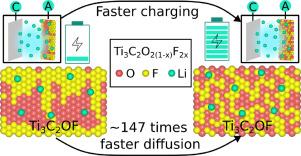Enhancing MXene electrochemistry through spatial control of O and F termination distributions
IF 8.9
2区 工程技术
Q1 ENERGY & FUELS
引用次数: 0
Abstract
MXenes have attracted considerable attention as potential electrode materials due to their adjustable chemical properties while retaining excellent metallic conductivity. Mixed surface functionalization, exemplified by O and F terminations on TiCOF MXenes, dictates electrochemical performance, yet the specific role of their spatial arrangement is poorly understood. This study utilizes a synergistic combination of density functional theory (DFT), kinetic Monte Carlo (KMC), and ab initio molecular dynamics (AIMD) to investigate how the nanoscale distribution of surface terminations governs Li transport and storage. DFT calculations identify distinct local neighbourhood environments characterized by unique Li diffusion barriers, challenging the simplification inherent in weighted-average compositional models. KMC simulations over 100 random O/F configurations show a 147-fold variation in Li diffusivity at room temperature, despite identical compositions. Furthermore, a composition-dependent analysis indicates that F-rich mixed-terminated surfaces facilitate faster Li diffusion compared to O-rich counterparts. The accuracy of the KMC model itself is validated by AIMD results, ensuring reliable dynamic predictions. Additionally, we show that the theoretical Li storage capacity is sensitive to these local termination environments. These findings reveal that, even at constant composition, the spatial configuration of surface terminations critically impacts electrochemical behaviour. This underscores the limitations of averaging approaches and highlights local termination structure as a key design parameter. Nanoscale control of termination patterns can significantly enhance MXene performance, enabling a new approach to modelling and optimizing 2D materials.

通过空间控制O和F端分布增强MXene的电化学性能
由于MXenes具有可调节的化学性质,同时保持优异的金属导电性,因此作为潜在的电极材料受到了广泛的关注。混合表面功能化,例如Ti3C2O2(1−x)F2x MXenes上的O和F末端,决定了电化学性能,但它们的空间排列的具体作用尚不清楚。本研究利用密度泛函理论(DFT)、动力学蒙特卡罗(KMC)和从头算分子动力学(AIMD)的协同组合来研究表面末端的纳米级分布如何影响锂的运输和储存。DFT计算识别出具有独特Li扩散屏障的不同局部邻域环境,挑战了加权平均成分模型固有的简化性。KMC模拟了100个随机的O/F结构,结果表明室温下的Li扩散系数变化了147倍,尽管组成相同。此外,一项成分依赖分析表明,富f的混合端表面比富o的混合端表面有利于更快的Li扩散。AIMD结果验证了KMC模型本身的准确性,保证了动态预测的可靠性。此外,我们还表明理论锂存储容量对这些局部终止环境很敏感。这些发现表明,即使在恒定的成分下,表面末端的空间构型也会严重影响电化学行为。这强调了平均方法的局限性,并突出了局部终端结构作为关键设计参数。终端模式的纳米级控制可以显著提高MXene性能,使建模和优化二维材料的新方法成为可能。
本文章由计算机程序翻译,如有差异,请以英文原文为准。
求助全文
约1分钟内获得全文
求助全文
来源期刊

Journal of energy storage
Energy-Renewable Energy, Sustainability and the Environment
CiteScore
11.80
自引率
24.50%
发文量
2262
审稿时长
69 days
期刊介绍:
Journal of energy storage focusses on all aspects of energy storage, in particular systems integration, electric grid integration, modelling and analysis, novel energy storage technologies, sizing and management strategies, business models for operation of storage systems and energy storage developments worldwide.
 求助内容:
求助内容: 应助结果提醒方式:
应助结果提醒方式:


